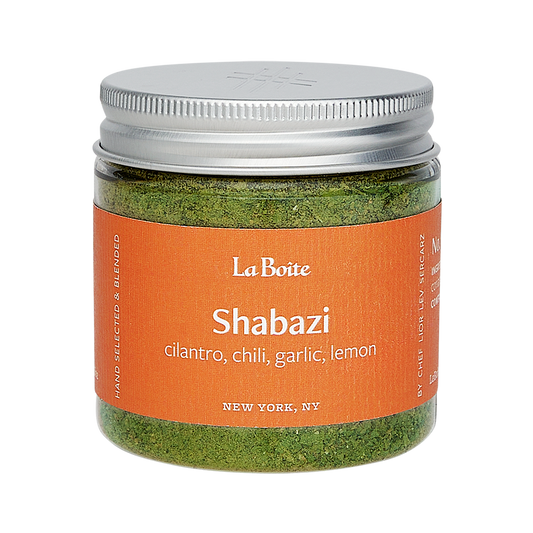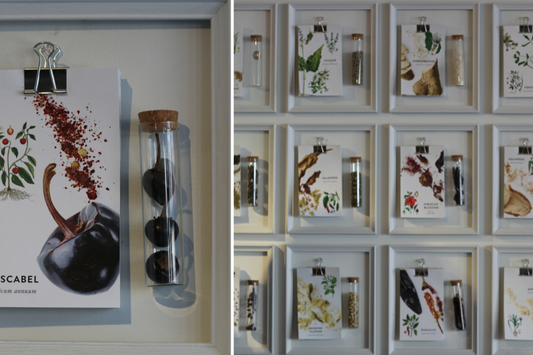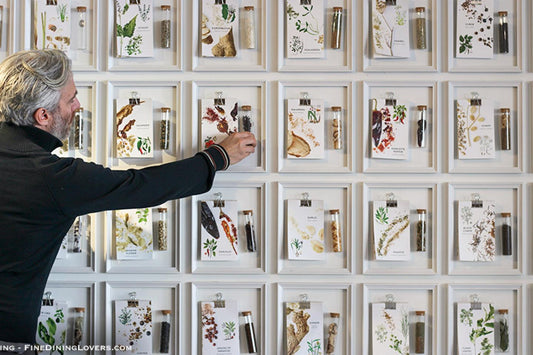Lessons from Lior Lev Sercarz: Buying, Storing and Cooking with Spices
By Emily Thelin
“There’s nothing wrong with buying ground spices,” says spice master Lior Lev Sercarz of New York’s La Boîte à Epice. Here, he shares more eye-opening tips to properly using and preserving spices.

Spices from La Boîte à Epice.
Photo © Thomas Schauer.
Is it better to buy whole spices than ground?
There’s nothing wrong with buying ground spices. A good-quality ground spice will last as long as a whole one. You can’t expect everyone to have a spice grinder or a mortar and pestle. We live a different lifestyle and we need things that are more accessible.Is it best to toast whole spices before using them?
You can toast them if they’re going to go into a raw preparation. If you’re going to sauté them, there’s really no need. Toasting has two downsides: You have to be really careful because you can burn them, and once you start smelling the spice while toasting, it means that vapors are coming out, and whatever is gone is gone. So the more you toast them, the more they lose some of their flavors. If you’re going to toast and use them right away, it’s fantastic, but if you use them six months later you will find they’ve lost a lot of their taste.
How do you choose which spices to cook with?
It all depends on how you want to cook, and what you want to serve it with. Is it for lunch? Dinner? Something light or heavy? It’s like a wine. Thank god we are past the era where white wine was for fish and red was for meat. It depends on what you feel like, on your mood.
You might be in the mood for something more herbaceous, so then you’re going to use something green like rosemary or tarragon, oregano, sage or hyssop. If you were craving something tangy, maybe you’d look more to the citrus family, whether dried citrus like Persian lemons or sumac or coriander. For something spicy or energetic, different peppers or chiles can come into play; or sometimes you’re craving that grilled sensation, so things like smoked paprika or smoked salt. In the winter we usually like warmer spices, like nutmeg, mace, clove and cinnamon. I’d say there’s probably only one spice that we come to again and again, and that’s salt. But aside from that it really depends on your mood.
Is it best to cook powdered spices before eating them?
No. You might want to apply less, only because you don’t want to eat a whole tablespoon of a certain powder. You just have to think, again, what is the point of this dish, how can I apply the spice to get that result? Let’s say you’re cooking some green beans: If you want the beans to taste of the spice throughout, it’s important to season them while you’re cooking them. The spice will penetrate the bean itself and have a longer flavor. If you only want the fragrance of the spice but the taste of the bean, sprinkle some on at the end. Especially if the beans are still warm and have just been steamed, they’ll release a great aroma. It’s not a matter of good or bad, it’s just a question of taste.With black, green, white and pink, how do you decide which peppercorns to use?
To me white and green pepper have lighter, fresher notes, so I’ll go towards those if I’m doing a dish with more vegetables or salad or even seafood. If I’m cooking something smokier or heavier, I’d go towards a black pepper. If I’m looking for a little sweetness, pink peppercorns are great.
Aleppo, Urfa, chipotle—how do you distinguish between all the different chiles?
Most chiles bring a little bit of heat. Some have a smoky note, like Urfa or chipotles, which are dried and smoked jalapeños. Some like Aleppo have a little acidity, some even a little sweetness. Ancho chiles are more warm and deep. Cayenne has a nice balance between heat and acidity. Urfa is very rich in oils, and notes of chocolate or wine tannin, a very complex flavor.
What spices might you use with…
Beef?
If it’s a good cut from a good place, good beef can be so rich, sometimes salt and pepper is the only thing you need. But let’s say you want to be a real purist, why not make it fun and season it with different peppercorns? Use green and black and pink and white, and get all their great qualities. Then pick a grain of salt that’s a bit more humid, like a gray sea salt, to discover a great texture. The saltiness won’t hit you right away, only as you eat will it melt in your mouth with all the beautiful flavors of the pepper and beef itself.
If it’s a lighter preparation, like a steak salad for lunch on a hot day, I’d probably do something more in the herb family with a light note of chile pepper. Or later in the day with a more substantial preparation, maybe I’d give it some sort of crust with coarsely ground coriander and other whole seeds as well as peppercorns.
Lamb?
Lamb is very versatile. Often when we think lamb we think North African preparations. And it works fantastically with cumin, cinnamon, caraway seeds or chile—whether in a marinade or dressing. And they have nice, coarse textures. You can also make a more delicate braised lamb with rose petals.
Chicken?
For simple, roasted, good-quality chicken, I’d go with herbal things like oregano—or why not throw in fun things like fenugreek leaves and get a curry sensation just by using leaves? If you’re going to braise it, then spices like paprika or turmeric might come into play, since they develop better when they steep in that braising liquid and penetrate the meat. Then you get a rich, nice flavor in the meat itself, not only on the outside.
Salmon?
If I was going to roast it in the oven, I might use some dried basil and tarragon, some rosemary and garlic. If I bake it in the oven, I might use some green anise and caraway seeds and baste it as I go along. While they roast they’ll release their great aromas into the roasting liquids and go into the fish. If I serve it raw in sashimi, I will just put a little Aleppo chile and salt.
Green beans?
For a very simple dish of steamed beans, once they were cooked, I would season them with a great salt with a nice texture to it, like a coarse sea salt, then maybe with some citrus, either orange or lemon, and maybe also with a little bit of coarsely ground anise or caraway seeds, and a drizzle of olive oil. If I was to grill them, I might marinate them in a little olive oil and a pinch of Aleppo and Urfa chile peppers. The grill would create that beautiful charred, even caramelized crust. If I was to braise them, maybe I would use something like a smoked paprika, and maybe a little ground coriander and ground mace—more concentrated spices, which are going to develop their full potential through braising. Or again, with the steamed green beans, I might grate a little nutmeg on top to release its beautiful floral aroma.
Carrots?
For a grated carrot salad, I would probably add something that’s very pronounced right away, like the heat kick of cayenne, or chipotle with its beautiful smokiness. A little sumac could bring great tang. A few whole mustard seeds could provide great texture: Between bites of the soft carrots, all of a sudden you’d start chewing on these great mustard seeds and release their beautiful heat. For a carrot puree, I might cook the carrots in carrot juice or water with ginger to infuse the carrots. I might add some fennel seeds to add a great licorice or anise note. And then I’d puree the carrots with the spices in them; I wouldn’t take the spices out, which so many do. I often look for warmer spices when I roast, so if I was roasting carrots in a pan with some butter and olive oil, I might throw in some cumin seeds that have a more earthy note and maybe a stick of cinnamon so it can slowly release all these beautiful oils in the pan; maybe even a pod or two of cardamom.
Green leafy vegetables?
If you were to braise kale, or Swiss chard, I would add something like coriander, which would bring some nice citrus flavor to the leaves. Or I like to add a little paprika, I think the sweetness counterbalances the bitterness that some greens have. I like to add mustard also; mustard seeds or mustard powder, since they add a nice little heat but without being extremely hot.
Chocolate mousse or hot fudge sauce?
Citrus is nice, whether it’s orange or lemon. Sesame seeds bring in a nice texture and nuttiness. Ground black pepper or different types of chile also work well: You have acidity and sweetness in the chocolate, then all of a sudden you get heat. And if they’re coarsely ground you get crunch.
Any food that does not work well with spice?
I think every food works well with spice to a certain degree. I think that adding a spice—or several—is pretty much essential to everything. Even salt is a spice. Seasoning is a key element in cooking.
Any unsung spice-food combinations?
I wish people would eat more spices as is. Not just let them melt or infuse or disappear into a preparation, but leave them in the preparation, sprinkle them into a salad, learn how to eat whole seeds, like fennel and coriander and cumin and anise and caraway. Just enjoy them for what they are, without necessarily having to grind, smash or puree them, but just enjoy them for their texture, really discover what they are. Whether it’s fish or meat, rice, pasta, vegetables, a yogurt or even cheese, try to incorporate them, and don’t run directly to the powder form. Try to experience the textural aspect of the whole spice.
Storing Spices
How long do most spices keep?
It really depends, but it’s generally agreed upon that spices are best used up within 10 months to a year after purchase, particularly if it’s in exceptionally good quality when you bought it.
What’s the best way to store spices?
There’s no need to freeze them, refrigerate them or vacuum-seal them. The big enemy of spices is humidity and heat. Under too much heat the essential oil will start to disappear, so you lose the strength. The humidity will start creating big lumps in the powder, or it can even spoil. Just keep them in a good sealed container away from heat. Glass is ideal.
Source: http://www.foodandwine.com/articles/lior-lev-sercarz-cooking-with-spices











